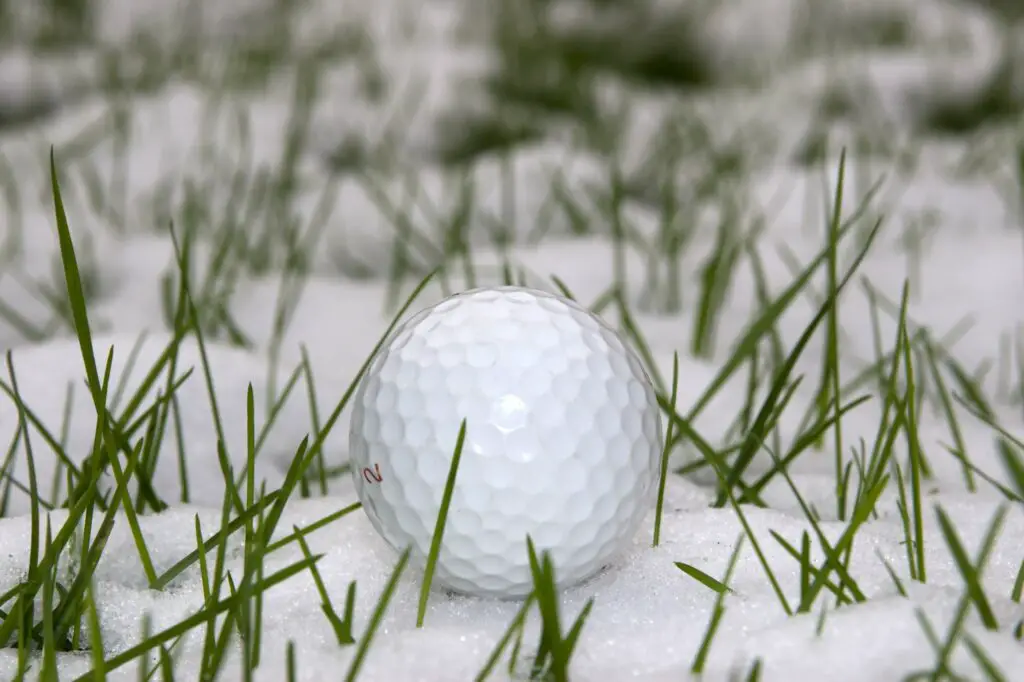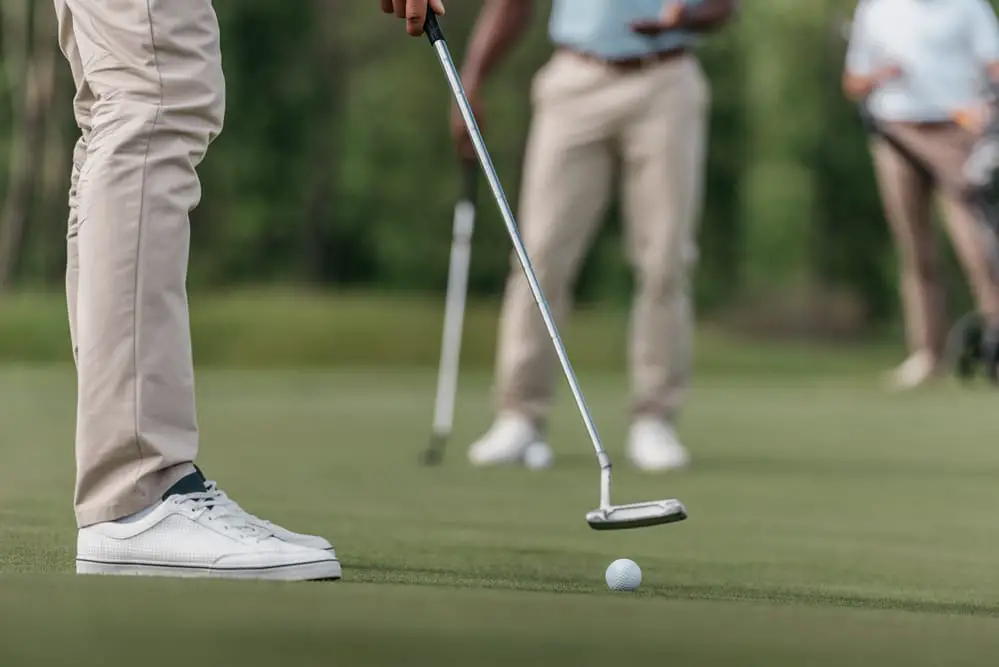Last Updated on October 16, 2023
Golfers have long sought to maximize the distance of their drives. But what many don’t realize is that the temperature can play a big role in how far a golf ball will travel.
The science behind golf ball flight is complex, but one thing is certain: colder temperatures can have an effect on how far a ball travels. Golf balls are made from materials that expand and contract with changes in temperature; as it gets colder, these materials become less elastic and therefore lead to reduced distances when hit by a club. My research has also shown that when temperatures drop below 40 degrees Fahrenheit, the effect on ball flight becomes even more pronounced.
In addition to air temperature, humidity levels also play an important role in golf ball flight performance. The colder air holds less moisture than warm air does, which means there’s less drag on the golf ball during flight and hence more potential for increased distances. This phenomenon is especially notable during winter months when humidity levels are at their lowest point of the year.
It’s clear that cold weather affects golf ball performance in measurable ways, but exactly how much? That’s what I’ll be exploring in this article. By analyzing my data and drawing on other research findings, I’ll provide readers with an understanding of how much colder temperatures can affect their drives so they can adjust their game accordingly.
Factors Affecting Distance
The distance a golf ball travels is determined by several factors. Temperature, wind resistance, spin rate, compression, and optimal temperature all have an effect on the distance the ball will go. Research has shown that colder temperatures can adversely affect the distance a golf ball can travel. This is due to a decrease in air pressure associated with colder climates. In these conditions, the air molecules become more spread out, and it takes less force to move them out of the way of the golf ball.
This means that wind resistance will be reduced compared to warmer temperatures, which can reduce the total distance travelled by the golf ball. Additionally, a decrease in temperature can also lead to a decrease in the spin rate and compression of the golf ball itself. Low spin rates and compression cause a reduction in lift and drag forces that are necessary for a golf ball to travel far distances. The optimal temperature for maximum distance is between 70-90° Fahrenheit (21-32° Celsius). In this range, enough lift and drag forces are generated for maximum distances when hit properly.
The Impact Of Temperature On Distance
Temperature can have a significant impact on golf ball distance. Cold air decreases the spin rate of a golf ball, which results in less backspin and, therefore, a greater distance travelled. Therefore, colder temperatures can lead to longer golf ball distances. However, when the temperature drops too low, it can cause the ball to lose its stability in flight due to decreased air density. This can severely reduce the distance travelled by the golf ball.
It is important for golfers to understand how cold weather affects their game in order to maximize their performance. The effects of cold temperatures on a golf ball’s flight characteristics are complex and vary depending on variables such as wind direction and speed, humidity levels, and air pressure. Therefore, it is recommended that players practice with their equipment in varying conditions to gain an understanding of how temperature affects their game.
In order to optimize performance in colder temperatures, golfers should take steps such as using softer balls or adjusting club selection and setups accordingly. Players should also be aware that colder temperatures may require more effort from their swing; this is because the club must generate more force to achieve its desired spin rate on the golf ball. With knowledge of how cold weather affects ball distance, players can better prepare themselves for any situation they may face on the course.
Wind Resistance And Its Effect On Distance
Wind resistance plays an important role in the distance a golf ball can travel. It can affect the trajectory of the ball, as well as its speed and spin. In ideal conditions, with no wind resistance, a golf ball can reach its maximum distance. However, when the air pressure changes due to temperature changes or wind gusts, the ball’s flight is altered.
Here are three factors to consider when it comes to wind resistance and its effect on distance:

- Air pressure: When air pressure changes due to temperature changes or wind gusts, it will affect the golf ball’s flight path.
- Ball spin: Wind resistance affects the spin on the golf ball, which in turn affects its trajectory and overall distance travelled.
- Impact on maximum distance: The greater the amount of wind resistance, the less likely it is that a golfer will achieve their maximum distance.
These factors prove that wind resistance has a direct impact on how far a golf ball travels. Understanding these effects can help players strategize and make adjustments to their game plan in order to maximize their performance on the course. Knowing how air pressure, ball spin and maximum distance are affected by wind helps golfers understand why certain shots may travel farther than others in certain conditions.
How Does Cold Air Affect Spin?
Cold air can have a significant impact on the spin when it comes to golf ball distance. Temperature affects the spin of a golf ball as it leaves the club face, as well as its trajectory and resistance to spin through the air.
| Cold Air | Spins | Resistance |
|---|---|---|
| Low Temp | High | Low |
| High Temp | Low | High |
Lower temperatures lead to more spin with a higher trajectory and lower resistance, while higher temperatures decrease the amount of spin and increase resistance. The density of cold air also plays a role in how it imparts spin on a golf ball, causing less backspin and more sidespin than warmer air. This leads to decreased accuracy and increased shot dispersion due to greater side-to-side movement of the ball.
To summarize, cold air has an effect on both the spin rate of a golf ball and its trajectory. Lower temperatures cause greater spin with higher trajectory but lower resistance, while higher temperatures decrease spin while increasing resistance. Additionally, cold air density contributes to less backspin and more sidespin, which decreases accuracy and increases shot dispersion.
How Does Cold Affect Compression?
Temperature is a major factor when it comes to golf ball compression. Cold air and temperature compression have a significant impact on how far a golf ball can travel. When the temperature drops, the air pressure around the golf ball decreases, resulting in less compression. This means that when hitting a golf ball in cold temperatures, players will not get as much distance as they would under normal conditions.
To ensure optimal performance, it is important for players to take into account the temperature before hitting a golf ball. Taking into consideration cold air compression and temperature will help players achieve their desired results and maximize their chances of success while playing in colder climates.
What Is The Ideal Temperature For Maximum Distance?

The ideal temperature for a golf ball to travel the maximum distance is not an exact science. However, it’s generally accepted that colder air can reduce spin rates and compression rates, reducing the overall distance of the ball. This is because cold air affects golf balls in much the same way as cold temperatures affect any other object: it becomes harder and less flexible. Therefore, when looking to maximize distance, players should aim to tee off with a golf ball at a temperature within a few degrees of room temperature or slightly warmer.
In addition to this, wind speed plays an important role in determining how far a golf ball will travel. If there’s no wind, then colder temperatures can be beneficial as they reduce drag on the ball, allowing it to travel further than if it were exposed to warm air. However, if there is wind present, then colder temperatures can have an adverse effect by increasing drag on the ball and reducing its velocity. The best way to maximize distance in these conditions is to use a golf ball with higher spin and compression ratings that are designed specifically for windy conditions.
Therefore, while there is no exact formula for what temperature will give you maximum distance, it’s clear that warmer temperatures are generally more beneficial than colder ones due to their impact on compression rate and spin rate. Golfers should also take into account any additional factors, such as wind speed, when selecting their golf balls for maximum distance performance.
Frequently Asked Questions
Are There Any Techniques I Can Use To Adjust For Cold Weather?
When it comes to golfing in cold weather, there are several techniques that can be used to adjust for the temperature and ensure optimal ball flight control. These cold weather techniques include various adjustment methods and strategies for controlling the ball’s trajectory.
Techniques for adapting to cold temperatures:
- Adjustment methods:
- Choosing a driver with less loft and more weight
- Hitting with a lower spin rate on your shots
- Using a harder golf ball
- Golfing strategies:
- Aiming slightly right if the wind is blowing left-to-right
- Practising various shots so you can adjust accordingly when needed during the round
- Taking more club than normal when hitting the wind
- Ball flight control:
- Keeping your swings smooth and consistent throughout the round, regardless of temperature or wind conditions
- Increasing swing speed by focusing on accelerating through the ball
- Making sure you have proper contact with the ground during your backswing and follow-through
A golfer must be prepared to make quick adjustments using these tools in order to adapt to changing conditions. Therefore, having an understanding of how the temperature affects their game will allow them to maximize their performance no matter what weather conditions they encounter out on the course.
Is There A Difference In Golf Ball Distance Between Cold Weather And Hot Weather?
Golfers often wonder if there is a difference in golf ball distance between cold weather and hot weather. With the temperature playing an important role in the game of golf, it is essential to understand how it affects the distance of the ball. This article will explore the effect of temperature on golf ball distance and present some tips to help golfers maximize their performance in both hot and cold weather conditions.
To ensure your shots maintain distance in various conditions, here are some tips:
- Make sure you tee up your ball correctly so that you get maximum launch angle
- Choose a harder compression golf ball for colder climates
- Use thicker grips to keep your hands warm and improve grip pressure
- Dress appropriately for each climate condition, so you remain comfortable and focused on your game
These tips can help ensure that you maintain consistent distances regardless of temperature changes during your round. While adjusting to different temperatures may take some time, understanding how temperature affects your game will ultimately help you become a better golfer overall.
Conclusion
Overall, the cold weather can definitely affect golf ball distance. It is important to be mindful of this and make adjustments accordingly. The type of golf clubs used, other elements such as wind, and techniques to adjust for the cold can all help you ensure that you don’t lose too much distance due to the cold temperatures.
When comparing cold and hot weather, there is a marked difference in terms of golf ball distance. When the temperature is colder, the air pressure is lower, which means that when a ball is hit, it will most likely travel with less speed than if it were hit in warm weather. As such, in order to get maximum distance from your shots in colder temperatures, you need to use suitable golf clubs and adjust your technique as needed.


